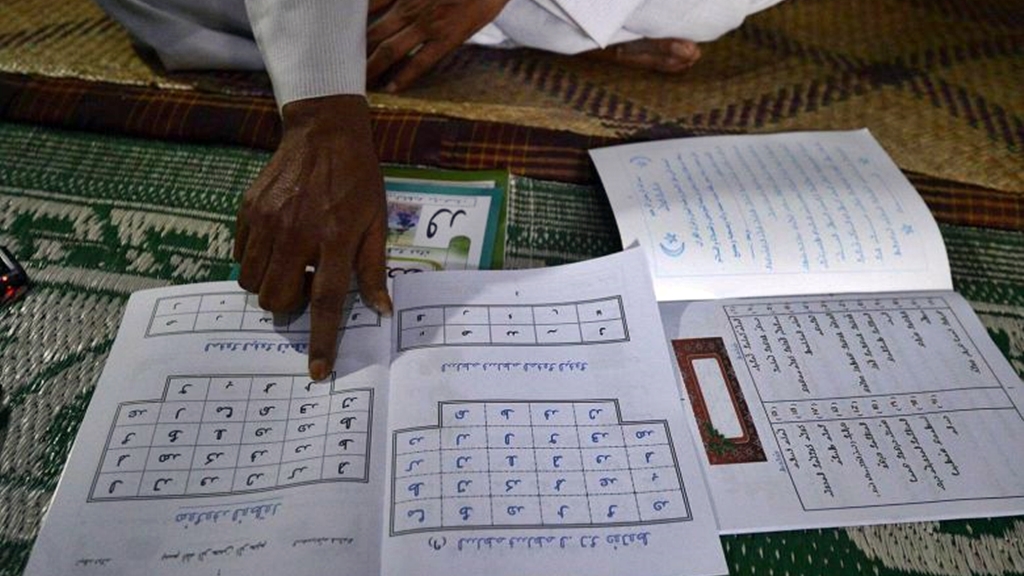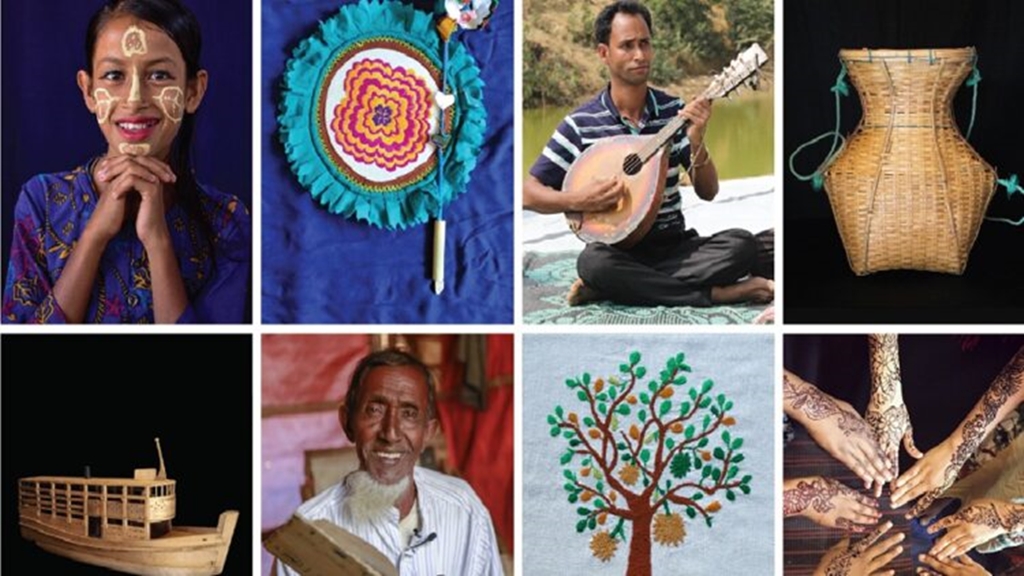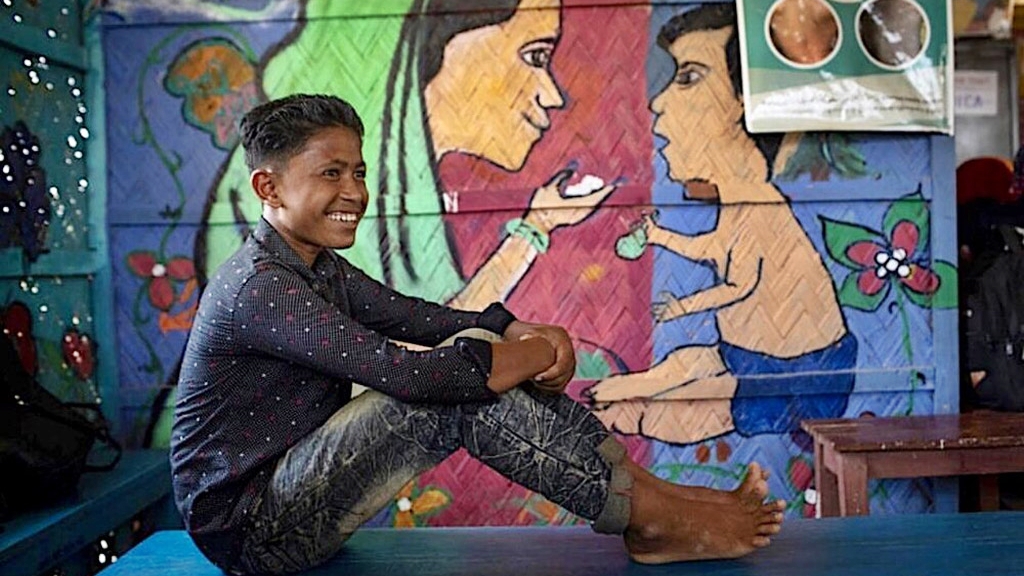
Rohingya Language
- 30/08/2012
- 2
Rohingya (Ruáingga) is the spoken language of Rohingya people which is similar to Chittagonian language spoken in the neighbouring Chittagong region of Bangladesh. The earliest Rohingya writing dated back over 350 years and it used Arabic script. However, our writing was lost during the British colonial period from 1826 until 1946 and therefore English, Urdu and Farsi languages were mainly used for written communications. Then Hanifi script, which is a blend of Arabic, Burmese and Roman scripts, was developed after the independence of Burma.
The Hanifi failed among the people due to difficulty in using this script on computers. The latest writing known as Rohingyalish is based only on Roman alphabets which are readily available on all modern media. This script proved to be extremely easy to learn and understand as the written and spoken language match very closely.
Examples of Rohingyalish:
1. Hi/Hello – Assolamu Aláikum. (Translation: Peace be upon you)
2. How are you? – Tuñí keén aso?
3. What is your name? – Tuáñr nam ki?
4. Where do you stay? – Tuñí hoçé táko?
5. Where is your house? – Tuáñr gór hoçé?
6. I am Rafique (or) My name is Rafique. – Aññí Rofíque(or) Añár nam Rofíque
7. How old are you? – Tuáñr boc hoddúr?
8. What do you do? – Tuñí ki goró?
9. It is great pleasure to meet you. – Tuáñr lói mili bicí kúci lager.
10. Thank you so much. – Tuáñre bicí cúkuria.
11. Welcome. – Tuáñre barái luwazar.
12. Hope to see you again. – Acágorir abbar dola óiyoum.
13. Ok. – Thík case.
The Rohingya Language and It’s Written Form
By Aman Ullah
Arakan, a continuation of the Chittagong plain, was neither purely a Burmese nor an Indian Territory until 18th century. Chiefly for its location, it had not only remained independent for the most part of history but also endeavored to expand its territory in the surrounding tracts whenever opportunity came. It is a natural physiographic unit clearly separated from the rest of Burma by a long and high impassible hill range of Arakan Yoma and also located far away from Indian capitals. The relation Chittagong and Arakan is influenced by geographical, cultural and historical considerations.
Culturally, socially, economically and politically the peoples of Arakan were independent for centuries. Hinduism and Buddhism spread from India, whereas Islamic civilization began influencing Arakan from the 7th century. As such, her relation with western Muslims states is millennia-old.
Across the last two thousand years, there has been great deal of local vibrancy as well as movement of different ethnic peoples through the region. For the last millennium or so, Muslims (Rohingyas) and Buddhists (Rakhines) have historically lived on both side of Naaf River, which marks the modern border with Bangladesh and Burma. In addition to Muslims (Rohingyas) and Buddhists (Rakhines) majority groups, a number of other minority peoples also come to live in Arakan, including Chin, Kaman, Thet, Dinnet, Mramagri, Mro and Khami etc.
The Rohingyas are descended from local indigenous tribes who lived in Arakan since the dawn of history. They trace their ancestry to Arabs, Moors, Pathans, Moguls, Bengalis and some Indo-Mongoliod people. Early Muslim settlement in Arakan dates back to 7th century AD. They developed from different stocks of people and concentrated in a common geographical location from their own society with a consolidated population in Arakan well before the Burman invasion in 1784.
The influence and power of the Muslims grew in Arakan to the extent of forming their own administrative system. There were Muslim rulers, nobles, Qazis, scholars, generals and poets etc. who developed the country’s administration, shaped a healthy socio-cultural life of the people, encouraged the growth of Islamic culture and civilization and replaced Muslim heritage in Arakan.
Like every people on the earth, the Rohingya has also their own language. Rohingya language is spoken in by the Rohingya people who are original inhabitants of the Arakan state of Burma. It is a member of the Bengali-Assamese sub-branch of the Eastern group of Indo-Aryan languages, a branch of the wider and vaster Indo-European language family. Its sister languages include Sylheti, Chittagonian, Bengali, Assamese, Odia, the Bihari languages, and also less directly all other Indo-Aryan languages such as Hindi. Like other Bengali-Assamese languages, it is derived from Pali, and ultimately from Proto-Indo-European.
Before Aryanization of the region they had their own spoken language. Some of pre-Aryan usages are still current in their language such as:
Bil (Flooded land), dhala (narrow serpentine mountain track), ghona (narrow valley or small lowland enclosed by the hill), Juri (canal), Kora (small piece of land), kum (underground hollow or depression of land), khola (stretched field) etc.
After the Aryanization of Arakan, their language evolved out of Sanskrit and a spoken dialect called Magadhi Prakrit. During the fourth to tenth century AD, there were found many inscriptions in Arakan region such as, stone inscriptions, bell inscriptions, brass plate inscriptions and lithic inscriptions in Sanskrit script.
The kingdom of Arakan had come in close cultural contact with the Muslim Sultanate of Bengal since fifteenth century so much so that many of the Buddhist rulers of the country adopted Muslim names for themselves, appointed Muslim officials in their court and even inscribed the Kalima on their coins. It was due to cultural superiority of Muslim Bengal that in the government of Arakan the high positions like Prime Ministers, Ministers, Generals, Uzir, Qadi or judge of Diwani, Fauzdari etc, were held by the Muslims. So the Bengali literature received great patronization in Arakan royal court. But before the end of the seventeenth century this patronization of Bengali culture ceased to exist. Among the Muslim poets who flourished in the Arakan court poet Daulat Qadi and Alaol were prominent. Other poets were Magan Siddiqui and Mardan.
Their writings were both in Bengali, Brajabuli and Awadhi mostly in Nagaric character. Bhojpuri is an Indo-Aryan language spoken in Bhojpuri region of North India and Nepal. Bhojpuri remains in use, and it is locally called Bojpury. Awadhi is an Eastern Hindi language of the Indo-Aryan branch spoken in northern India. It is primarily spoken in the Awadh region of present-day Uttar Pradesh, India. The Awadhi language was brought to Arakan from the West by the Muslims of Sylhet. During the Sultanate rule Sylhet was the permanent border-outpost of Sultans. When the authority of Sultans extended towards east and south east of Sylhet it created a congenial atmosphere for the culture of Bengali Muslims at different places. Nagari or Devnagari is a part of Brahmic family of scripts of Indias, Nepal, Tibet and South-east Aisa. It is a decedent of the Gupta script. It is written from left to right. After Bengali, the regional culture language, Persian seems to have been the second language of communication in those days.
However, the Padmavati of Alaol was circulated in Arabic script also in addition to Bengali. There are about 50 such Bengali manuscripts written in Arabic characters in Abdul Karim Sahitya Visarad’s collection in Dhaka university library. Considering the absence of printing press in those days and hardships involved in transcribing long and whole Bengali works in Arabic scripts.
After the fall of Arakan under the Burman in 1785, there was no scope for the Rohingyas further to evolve their language. Slowly, slowly, the Rohingya language reduced as merely a spoken language or a dialect. During the British colonial period they introduced Urdu language in schools for Muslims in order to make congenial atmosphere for their administration.
While Arakan was under British rule (1826–1948), the Rohingya people used mainly English and Urdu for written communication. Since independence in 1948, Burmese has been used in all official communications. Since the early 1960s, Rohingya scholars have started to realize the need for a writing system suited to their own language.
In 1975 a writing system was developed using Arabic letters; other scholars adopted Urdu script to remedy some deficiencies of the Arabic. Neither proved satisfactory, however, and most Rohingyas found it difficult to read the language in either version.
Following these attempts, Maulana Hanif achieved a dedicated right-to-left alphabet for the Rohingya language in 1983. Named after its author, the Hanifi alphabet is a modified form of the Arabic alphabet, with additional borrowings from Latin and Burmese alphabets.
In 1999 E.M. Siddique Basu was able to simplify the Rohingya writing using Latin letters. It is an intuitive writing system which can be learnt easily and is known as Rohingyalish or Rohingya Fonna that uses only 26 Roman letters, five accented vowels, and two additional Latin characters for retroflex and nasal sounds.
When one thinks about language, it really is a miracle. This is because it is a “set of words, or sounds, that collectively is understood by a whole social system that each word, or sound, or even spelling is the same meaning for all. That alone is a miracle—evolutionists, please explain how this happens so easily among various social groups, various languages? Especially by the ones under 5 years of age, as being the easiest ones to learn language?
When one thinks about a set of Alphabets or writing system of a language or a system representing a language in written form, there must be required the followings: –
1. At least one set of defined base elements or symbols, individually termed characters and collectively called a script;
2. At least one set of rules and conventions (orthography) understood and shared by a community, which arbitrarily assign meaning to the base elements (graphemes), their ordering and relations to one another;
3. At least one language (generally spoken) whose constructions are represented and able to be recalled by the interpretation of these elements and rules.
Moreover, a standard language is a language chosen by the main power of a country or region and forced upon everyone else. It is not based off the most commonly spoken language, though it usually ends up being the same, but it is based off whichever language a country’s leaders choose, or their main language. It has nothing to do with the people in a country, only with a country’s government or leaders. Otherwise, in the absence of a government or main power of authorities, there must at least need a popular consensus of the majority peoples who spoke this particular language.
A language is a complex structure represented in the minds of speakers. There needs necessary tools to understand this structure. There needs theoretical ideas in the major areas of linguistics such as phonetics, phonology, syntax, and semantics as well as the applications of these to the study of child language acquirement.
Hence, any attempt to make a language in written form never be an individual task. It is an up-hill task and collective task. It prerequisites a unified approach to language from several perspectives. It’s required a team of distinguished linguists.








Bitter coffee
No offence but referring to Rohingyas as generally “muslims” and Rakhines as “Buddhists” makes it inaccurate. Rohingyas and Rakhines are ethnics while muslims and Buddhists are religions. Let’s not confuse religions and race. Thank you!